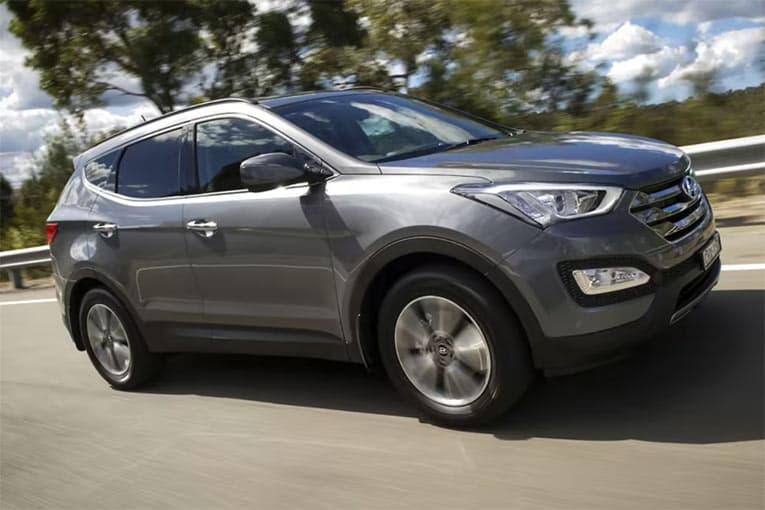Hyundai Santa Fe has got all-new looks. The exterior design is now sharper and gives the Santa Fe a modern Hyundai look. The front of the car looks massive with a hexagonal front grille and large, tear-drop headlights above the bumber. The lowered roofline, swept-back windshield and upswept lower edges to the rear side windows give the car sporty looks. The rear features wrap-around taillights and small roof-top spoiler, twin tailpipes and hexagonal mesh set into lower section of the bumber. Nice design feature are the deep doors that cover the side sills, ensuring the sills stay clean and that dirt is not transferred to occupants’ clothes during entry.
Designed on an all-new platform, the Santa Fe is a little bit bigger than before. The new Santa Fe is 40mm longer and 5mm wider than its predecessor. The body is 45mm lower making it more aerodynamic. Santa Fe’s ground clearance is 185mm. Although the car has the same 2700mm wheelbase, the redesigned interior offers more cabin space for occupants and has enabled front headroom to be increased by 11mm and front legroom by 38mm. On the second-row there is now 45mm more legroom, making it really spacious also for an adult passenger. Santa Fe is available as a 5-door and 7-door versions. The five seater version has a 585 litres cargo space, which can be increased to 1,680 litres when the second row seats are folded down.

In Europe, the Hyundai Santa Fe is powered by a Hyundai’s 2.2-litre diesel engine. The iron-block engine has an aluminium cylinder head with 16-valves and a high pressure commonrail injection system with Piezo injectors. With the variable geometry turbocharger, the four-cylinder diesel produces 197 horsepower (145 kW) from the displacement of 2,199cc. The engine can be paired either with a six-speed manual or the six-speed automatic transmission. Engine’s maximum torque depends on the transmission. With the manual the torque is 421 Nm (311 lb-ft) and with the automatic 436 Nm (322 lb-ft). The car’s performance isn’t quite sporty, but the huge torque the four-cylinder produces moves this SUV nicely. Acceleration from zero to 100 km/h takes 9,8 seconds with the manual and 10,1 seconds with the automatic.
The engine has been significantly upgraded for improved fuel consumption and reduced emissions. For example moving the exhaust gas recirculation unit (EGR) downstream from the exhaust manifold and diesel particulate filter (DPF) has enabled the exhaust gases to pass through the DPF and cool further before being recirculated back into the combustion chamber. This reduces nitrogen oxide emissions and enhances fuel efficiency. Santa Fe with the 2.2-litre engine, automatic transmission and four-wheel drive has the average fuel consumption 6,7 l/100km and CO2 emissions of 175 g/km.

The manual gearbox would be more fuel efficient, but the automatic transmission is more comfortable and feels like a natural partner for this 2.2-litre diesel. Although this transmission is a regular torque converter automatic, it incorporates a unique flat torque converter. Its innovative layout makes it compact and lightweight. The automatic transmission weighs 12kg less than a conventional automatic and can boost fuel economy by up to 12%.
Depending on the market, the Hyundai Santa Fe is available as a 2WD and AWD versions. The all-wheel-drive system available on Santa Fe models is an on-demand system. When sensors anticipate a loss of grip at the front wheels, power is automatically redistributed between the front and rear axles. The default power distribution is 100% to the front wheels. When slippery conditions are encountered, up to a 50% of the torque can be sent to the rear wheels. For especially slippery conditions all-wheel drive can be locked delivering a 50% front / 50% rear power split at speeds up to 40 km/h (25 mph).
Specification
Engine
- Diesel
- 4-cylinder
- 2199cc
- Turbo
Power
- 145 kW (197 hp) / 3800rpm

Torque
- 436 Nm / 1800-2500rpm
Transmission
- 6-speed automatic
- AWD
0-100km/h / 0-62mph
- 10.1 seconds
Top speed
- 190 km/h
Fuel consumption
- 6.7 l/100km
CO2 emissions
- 175 g/km










